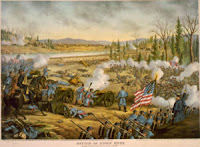 The Confederates took the advantage at the Battle of Stones River in Tennessee [aka the Battle of Murfreesboro] by attacking first. At dawn on December 31st 1862 while many of the Union men where having breakfast, two of Lieutenant General William J Hardee’s and one of Lieutenant General Leonidas Polk’s divisions strongly assaulted the right wing under Union Major General Alexander M McCook. By ten that morning the Rebels had managed to push the Union troops back about three miles, almost to the Nashville Pike. Only the units fighting tenaciously under Brigadier General Philip H Sheridan and Brigadier General James S Negley keep the battle from being a total Federal rout. At noon along the Nashville Pike troops under Major General Thomas Crittenden used infantry and artillery to push back a Confederate attack. The noise of battle was so loud that soldiers had to put cotton in the ears. As night came on the fighting died off. No one celebrated the New Year that night, as the two armies stayed in position for the next day.
The Confederates took the advantage at the Battle of Stones River in Tennessee [aka the Battle of Murfreesboro] by attacking first. At dawn on December 31st 1862 while many of the Union men where having breakfast, two of Lieutenant General William J Hardee’s and one of Lieutenant General Leonidas Polk’s divisions strongly assaulted the right wing under Union Major General Alexander M McCook. By ten that morning the Rebels had managed to push the Union troops back about three miles, almost to the Nashville Pike. Only the units fighting tenaciously under Brigadier General Philip H Sheridan and Brigadier General James S Negley keep the battle from being a total Federal rout. At noon along the Nashville Pike troops under Major General Thomas Crittenden used infantry and artillery to push back a Confederate attack. The noise of battle was so loud that soldiers had to put cotton in the ears. As night came on the fighting died off. No one celebrated the New Year that night, as the two armies stayed in position for the next day. Worth looking at
Stones River Bloody Winter Tennessee
Personal Recollections And Experiences Concerning The Battle Of Stone River (1889)
http://www.nps.gov/history/NR/twhp/wwwlps/lessons/40stones/40stones.htm





































